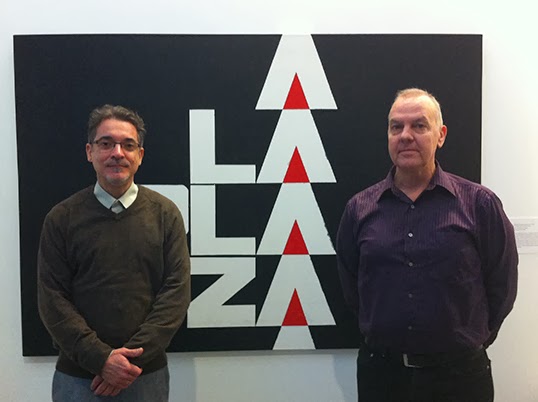
Co-curators Keith Wallace (right) and Antonio Eligio (Tonel) are proud of bringing new trends in Cuban art to Vancouver audiences. | Photo by Sonja Grgar
The Morris and Helen Belkin Art Gallery has an established history of showcasing Cuban art to Vancouver audiences. The Spaces Between: Contemporary Art from Havana (running from Jan. 10–April 13) is the gallery’s latest presentation of art from a country that has carved a unique place on the world stage, that has been romanticized as well as underestimated and misunderstood.
Co-curated by Keith Wallace, the gallery’s associate director/curator, as well as Antonio Eligio (Tonel), a renowned Cuban artist and critic now living in Vancouver, the exhibition aims to shed insight into life in Havana, as well as to build a conversation about new artistic trends that emerged as a result of recent socio-political developments in Cuba.
Reflecting change

Grethell Rasua’s Of Permanence and Other Necessities captures the many layers of the exhibition. | Photo by Sonja Grgar
Tonel, who has participated in the gallery’s 1997 Utopian Territories: New Art from Cuba exhibition as well as exhibited independently at the Belkin in 2000, sees substantial changes taking hold of Havana’s art world and attributes them to the persistent growth of the country’s market economy.
“Those changes in Cuban society are bringing with them issues such as the importance of capital and currency, [questions of] how to use bureaucracy and the idea that foreign culture is something that is beyond reach,” he says.
While issues of migration and social critique dominated art in the 1990s, various new economies in Cuban society and their relationship to everyday life seem to be the most prominent current trend.
Many of those economies relate to the ingenious approaches in urban agriculture such as Grethell Rasua’s With Your Own Flavour, a video which depicts a Havana woman who sells spices that she home-grows using the customer’s own feces as soil fertilizer.
Along with functional food production, several of the works deal with the dismantled aspects of agriculture such as Ricardo Elias’ Dry Gold, photographs that document the closure of numerous sugar mills after the breakdown of the Soviet Union eliminated Cuba’s most substantial export market.
Conjuring dialogue
It was vitally important to both Tonel and Wallace that the works in the exhibit mutually reference one another, rather than stand as isolated pieces.
“We saw the exhibition not as nice objects that you go and look at independently of each other, but wanted the whole thing to kind of build up as an experience,” says Wallace.
Documenting the difficult material reality of Cuban life was an unavoidable aspect of that conversation. Luis Gomez Armenteros’ A Sufi Dream is a sentence chiseled on the wall that reads as ‘Would you like to buy my misery?’, and as such seems to criticize the idealized portrayal of Cuba that is sold to the tourists along with beach vacation packages.
However, in addition to avoiding the exoticization of Cuban culture, Tonel and Wallace also wanted to portray its vitality and resilience through a series of atmospheric pieces such as Juan Carlos Alom’s video Havana Solo, which gives us a spontaneous slice of life in the city.
Grethell Rasua’s video Of Permanence and Other Necessities shows a close-up of a woman’s mouth sucking on a cactus as perhaps the ultimate symbol of extracting sustenance out of limited resources.
Exercising subtlety
Though they did not want to entirely avoid the political dimension in the exhibit, Tonel and Wallace chose to feature it in less overt ways.
“There is a tendency for us outside of Cuba to look for things political in Cuban artwork…and you can find it, but again it’s in that space in between, and in what’s not being said, and how you construct what you think you are looking at,” says Wallace.
For example, The Spaces Between is rife with works that examine the instability of truth in language. In Javier Castro’s video Black on Black, Cubans show off their Chinese character tattoos and the actual translation of the words appears on the screen against the tattoo owner’s often misguided understanding of their definition.
That connection between the artistic and the socio-political is something that both Tonel and Wallace wish the local audiences would make.
“I hope that people enjoy the work as art, but hopefully we invite them to look a bit deeper into certain aspects of [Cuban] reality,” says Tonel.
Wallace hopes that the artistic depiction of social changes taking place in Cuba will motivate Vancouver audiences to reflect on progress that is needed in their own backyard.
“[Canadians] feel that we live in this democratic country, but we are not really free, [and it is time] for us to think about our own situation and how we want things to change,” he says.
For more info on The Spaces Between: Contemporary Art from Havana, visit www.belkin.ubc.ca









